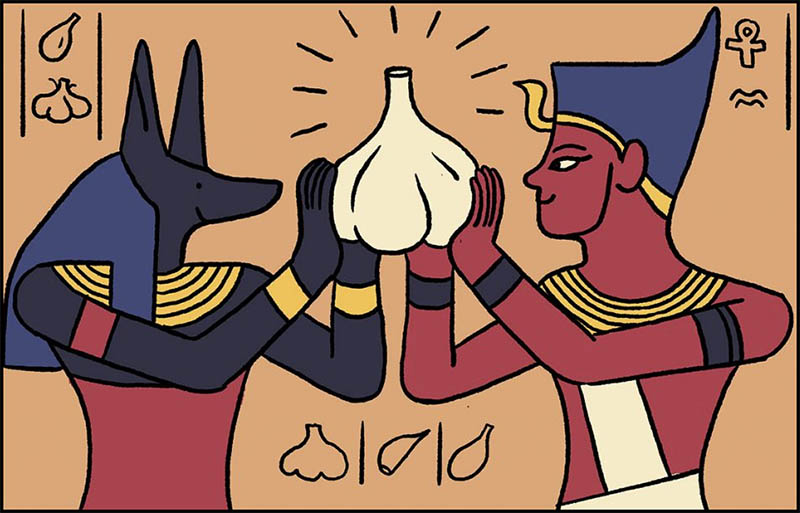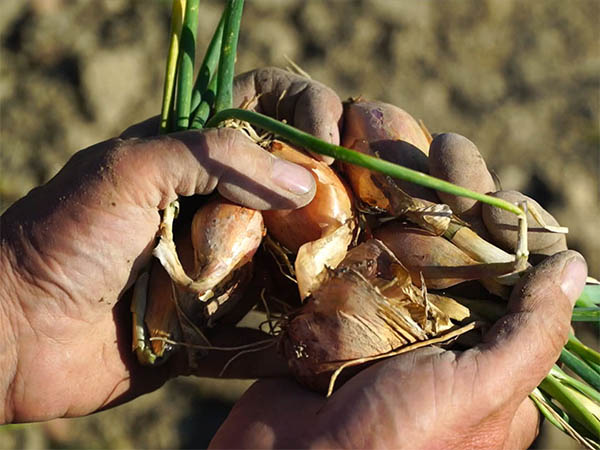History of shallot
Shallots are native to the Middle-East: their botanical name Allium ascalonicum (now officially Allium cepa gr. agregatum) refers to the Port of Ascalon, in Palestine, which is now known as the Ashkelon seaside resort in Israel.
Shallots were already a food staple in ancient Egypt, and Persians considered them to be a sacred plant!
Shallots were introduced to Europe by Crusaders returning from Palestine. From the 12th century onwards, shallots were cultivated in Brittany and in the Anjou, the two traditional shallot-producing French regions. To this day, shallots go on being traditionally cultivated in those two regions, however they are now also cultivated in the North of France and in the Drôme.
Shallots were already a food staple in ancient Egypt, and Persians considered them to be a sacred plant!
Breeders have created new varieties with a better shape, and improved yield and storage qualities. Nowadays, shallot farmers can choose from a selection of 13 varieties of certified shallot plants, many of which can also be purchased by amateur gardeners.

Medicinal and dietetic properties of shallot
Shallots have been a staple of the human diet as far back as Antiquity, and the Greeks and Romans even claimed they had aphrodisiac properties. Shallots are a favourite with gourmets, but are also a healthy food to be eaten as part of a balanced diet.
Like garlic and onions, and to a wider extent all vegetables belonging to the Allium family, shallots are a wonderful condiment with a wide range of nutraceutical properties.
Rich in minerals, vitamins and trace elements, shallots are a wonderful food for a well balanced healthy diet.
Just like garlic and onions, shallots offer amazing health benefits. Shallots share the same antioxidant properties as garlic, and the organosulfur compounds they contain — which give them that distinctive smell – help protect the body against certain types of cancer (especially those affecting the digestive tract). These properties are currently being investigated as they are not yet as well-known as those of garlic.

Remarkable nutritional qualities
Shallots are particularly rich in minerals, vitamins and trace elements. They also contain phosphorus, potassium, magnesium, manganese, iron and copper. They are rich in vitamin B6 (pyridoxine), which plays an important role in the functioning of the nervous and immune systems. Shallots are also a source of vitamin B9 (folic acid) which is essential to cell division and DNA synthesis, and which contributes to red cell formation. Shallots also provide vitamin C and vitamin A, two major vitamins that have multiple health benefits.
Shallots are also an excellent source of selenium, a trace element that protects cells against aging and contributes to healthy skin and hair. Combined with vitamin E, also found in shallots, selenium contributes to the formation of antibodies that defend the body against microbes and viruses.
Undeniable health benefits
Shallots contain quercetin, a flavonoid (vegetable pigment) that strengthens small blood vessels (capillaries) and reduces their permeability. This molecule helps prevent cerebrovascular disease and a number of inflammatory diseases (prostatitis, cystitis…). Quercetin is also believed to help lower ‘bad cholesterol’ (LDL).
Moreover, a peptide isolated from shallot, was shown in vitro to have antimicrobial and antifungal properties. These properties remain to be confirmed in humans consuming shallots.
Please consult the following sites: Passeport Santé for more information on the therapeutic and health benefits of shallots…
